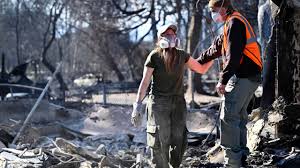SACRAMENTO, CA – In response to the escalating threat of wildfires across California, Governor Gavin Newsom has announced an accelerated timeline for implementing stricter fire-resistant home regulations in high-risk areas. The move aims to enhance public safety, reduce property damage, and fortify communities against the growing intensity of wildfire seasons.
A Growing Threat
California has long battled destructive wildfires, with recent years witnessing an alarming increase in frequency and severity. According to Cal Fire, the state experienced over 7,500 wildfires in 2023 alone, burning more than 1.2 million acres of land. Scientists attribute this surge to climate change, prolonged drought conditions, and the expansion of residential areas into fire-prone zones.
“These fires are becoming more intense and unpredictable. We can no longer afford to delay action,” Governor Newsom said during a press conference in Sacramento. “Strengthening building codes is a crucial step in ensuring our communities are safer and more resilient.”
New Regulations and Their Impact
The accelerated regulations mandate that new homes in designated high-risk fire zones adhere to updated fire-resistant construction standards. The key provisions include:
- Fire-Resistant Materials: Builders must use ignition-resistant materials such as treated wood, non-combustible siding, and fire-resistant roofing.
- Defensible Space Requirements: Homes must have a minimum of 100 feet of defensible space, reducing fuel for wildfires.
- Safer Landscaping Guidelines: Restrictions on flammable vegetation near structures will be enforced.
- Enhanced Ember Protection: Vents, windows, and other openings must be designed to prevent ember intrusion, a leading cause of home ignition.
The California Building Standards Commission has been tasked with expediting the adoption of these measures, originally set for 2026 but now slated to take effect by mid-2025.
Support and Opposition
The announcement has received widespread support from fire safety experts, environmentalists, and many homeowners living in fire-prone regions. “This is a game-changer,” said John Miller, a fire ecologist with the University of California. “Stronger regulations can significantly reduce the number of homes lost to wildfires and save lives.”
However, some developers and real estate groups have raised concerns about the costs associated with implementing these new requirements. “We support fire safety, but these mandates could drive up housing costs, making it harder for families to afford homes,” said Karen Thompson, a spokesperson for the California Home Builders Association.
To address affordability concerns, the state government has proposed financial incentives, including low-interest loans and grants for homeowners retrofitting existing structures to comply with the new standards. The California Department of Housing and Community Development is expected to roll out these assistance programs in the coming months.
Looking Ahead
As wildfires continue to pose a major threat to California’s communities, the urgency of implementing fire-resistant home regulations cannot be overstated. Experts believe that these measures, combined with responsible land management and improved firefighting resources, will play a critical role in reducing wildfire devastation.
“We have to think long-term,” Governor Newsom emphasized. “These regulations aren’t just about the next wildfire season; they’re about protecting future generations from the growing dangers of climate change.”
With enforcement set to begin in 2025, homeowners, builders, and local officials will need to adapt quickly. Residents in high-risk areas are encouraged to review the new regulations and explore available resources for fire-proofing their homes through the Ready for Wildfire program.
Conclusion
California’s accelerated fire-resistant home regulations mark a pivotal step in combating the increasing wildfire crisis. While challenges remain, the initiative underscores the state’s commitment to safeguarding communities and mitigating the impact of climate-driven disasters. With continued collaboration between government agencies, builders, and residents, California is poised to set a national precedent in wildfire resilience and home safety.
For more details on fire-resistant home regulations and available resources, visit the California Office of Emergency Services.
Disclaimer – Our team has carefully fact-checked this article to make sure it’s accurate and free from any misinformation. We’re dedicated to keeping our content honest and reliable for our readers.








